- My review after 1,400+ nights
- How the Pod has changed our sleep
- What’s new with the Pod 4
- Unboxing and setup video
- How (well) the temperature control system works
- Our take on the Eight Sleep mattress
- Our take on the Pod 4’s optional adjustable base
- Wireless connectivity and EMF concerns
- Sleep tracking capabilities and accuracy
- Pricing and discount code
- Eight Sleep vs. competing products
- Final verdict
The Eight Sleep system uses water-based cooling technology to help your body achieve and maintain an ideal temperature during sleep. This can increase the duration and quality of your sleep, making it more likely that you’ll wake up feeling fully rested and refreshed.
Additionally, the system features advanced, built-in sleep tracking technology (called the Active Grid) that can measure your heart rate, heart rate variability, and a range of other sleep-related biometrics.
My wife and I have been using Eight Sleep since August 2020, and we recently upgraded from the Pod 3 to the Pod 4 Ultra, which the company released in late 2024.
In this review, I’ll explain how Eight Sleep works and how it has changed our sleep for the better. I’ll also tell you what I love and hate about the new model, which offers some valuable improvements but also comes with some disappointing downsides.
First, it’s important to note that Eight Sleep can be used with any mattress, including your current mattress. While the company sells its own line of memory foam mattresses, the heartbeat of the system is the Pod, which contains the temperature control and sleep tracking technology.
So if you’re happy with your current mattress, there’s no reason to switch.
My Eight Sleep Review After 1,400+ Nights
Based on my research, as well as my first-hand experience with different types of bed cooling systems (including bed fans), I’m confident in saying that Eight Sleep offers the most advanced technology available.
We’ve used Eight Sleep for four years and have noticed a dramatic improvement in our sleep quality, as measured by factors such as how much time we spend in the restorative phases of sleep (deep and REM sleep), how quickly we fall asleep (sleep onset), how often we wake up during the night, and how refreshed we wake up each morning.
This review covers the complete Eight Sleep system, which consists of the following:
- The Cover, which contains the “Active Grid” technology that provides temperature control and sleep tracking. This cover can be used on any mattress (even the one you currently own).
- The Hub, which is the central engine that powers the Cover. This is where you add the water that gets circulated throughout the Cover (for the purpose of temperature control).
- The Base, which is an adjustable frame that comes with the Pod 4 Ultra.
- The 5-Layer Mattress, which is a relatively standard memory foam mattress designed with temperature regulation in mind.
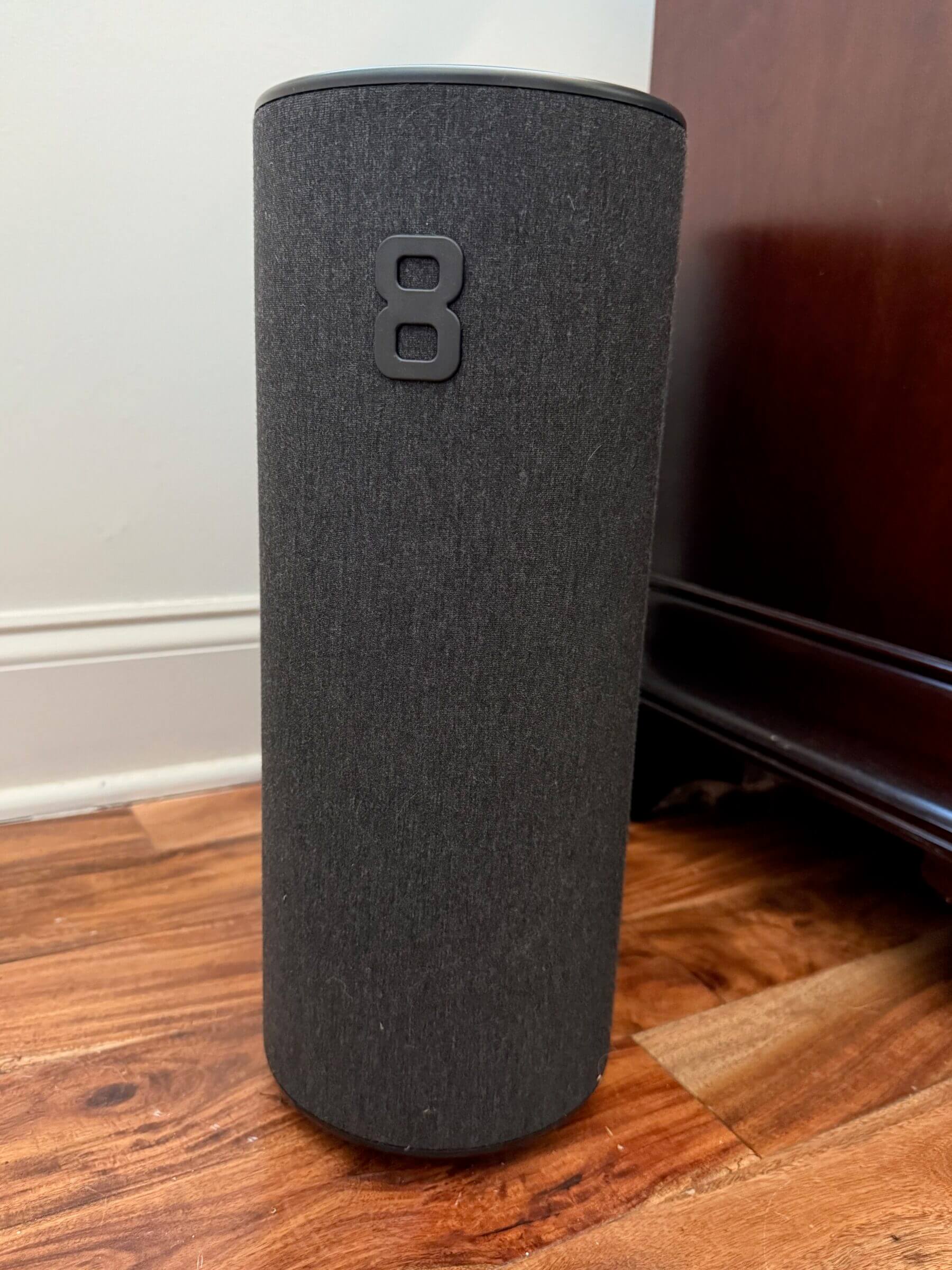
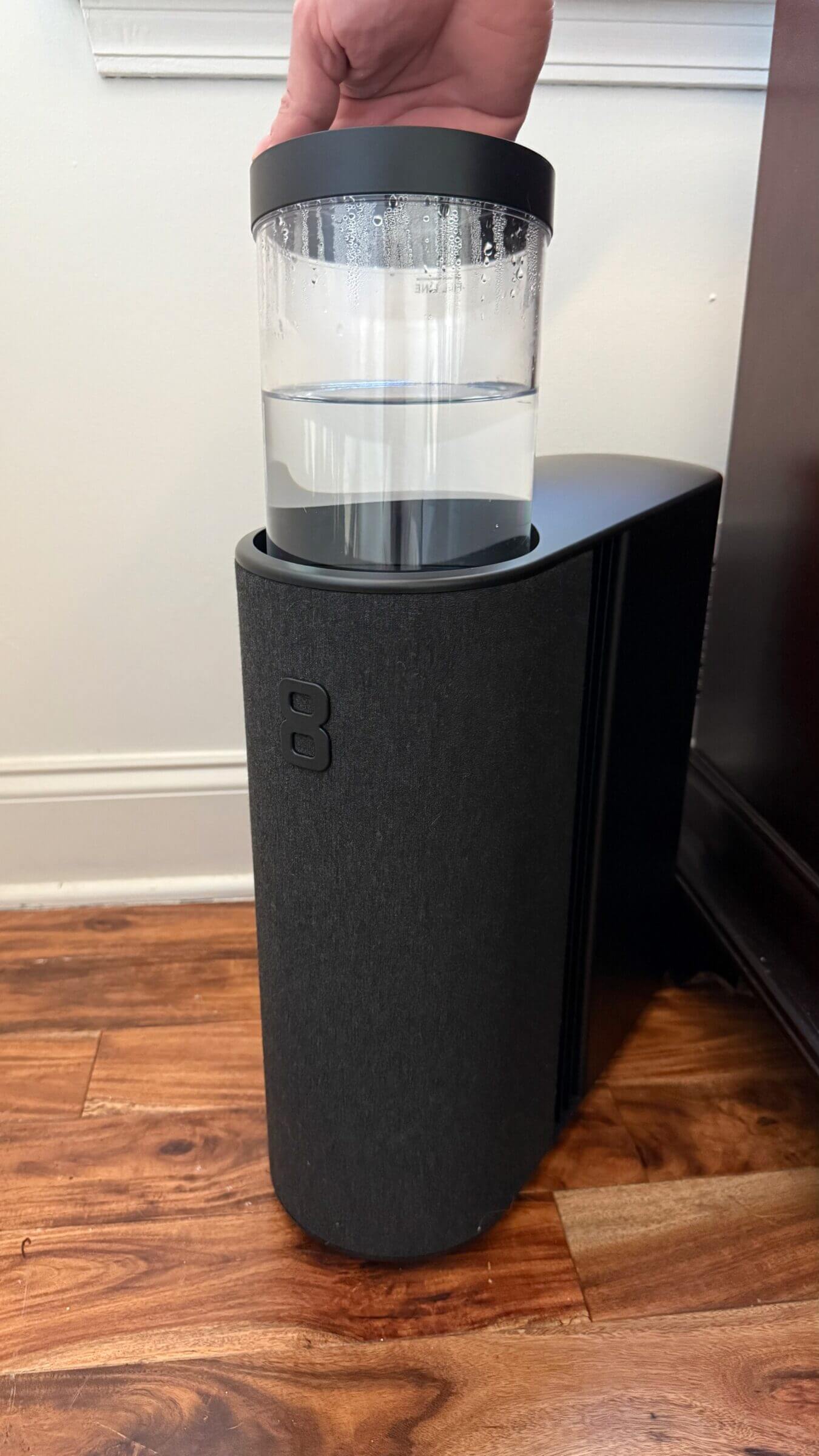
We sleep on the full Eight Sleep system, but you only need the Pod. The mattress is completely optional. We chose to go with the complete system because our old mattress was already 10 years old and ready for replacement. The adjustable frame is also optional, and I would not get it again (for all the reasons discussed later in this review).
Here are my key takeaways:
- It’s the most advanced mattress cooling system on the market, and it has made a significant difference in the quality of our sleep. In fact, we can no longer image sleeping without a temperature control system.
- Some of the system’s best features, including automatic temperature adjustments and access to your sleep metrics, require a paid subscription that costs $199 per year. Additionally, a one-year subscription is required when you purchase a new Pod.
- The integrated sleep and biometrics tracking technology is relatively accurate and insightful because it allows us to correlate lifestyle choices (e.g., late meals, sauna bathing or alcohol consumption) with changes in sleep quality and recovery. As a result, we can use that information to make better choices to further optimize our sleep performance.
- The Pod 4’s integrated tap sensors are a game-changer because they allow us to make quick temperature adjustments without requiring the use of the mobile app. (The Pod 3 does not have these tap sensors.)
- The system requires virtually no ongoing maintenance, except for refilling the water tank once every few months.
- Eight Sleep requires an active WiFi connection to function. If your WiFi service is disrupted, the system is rendered completely useless. So if your bedroom has spotty WiFi coverage, or if you regularly experience internet service disruptions, it’s not a viable option. Just as importantly, the WiFi requirement means that to use the system, you’re forced to expose yourself to potentially dangerous EMFs.
While the last point above may not be a concern for those who consider manmade EMFs harmless, it’s a major concern for us, and I’m incredibly disappointed that the system can’t work without an active internet connection.
How Eight Sleep Has Changed Our Sleep
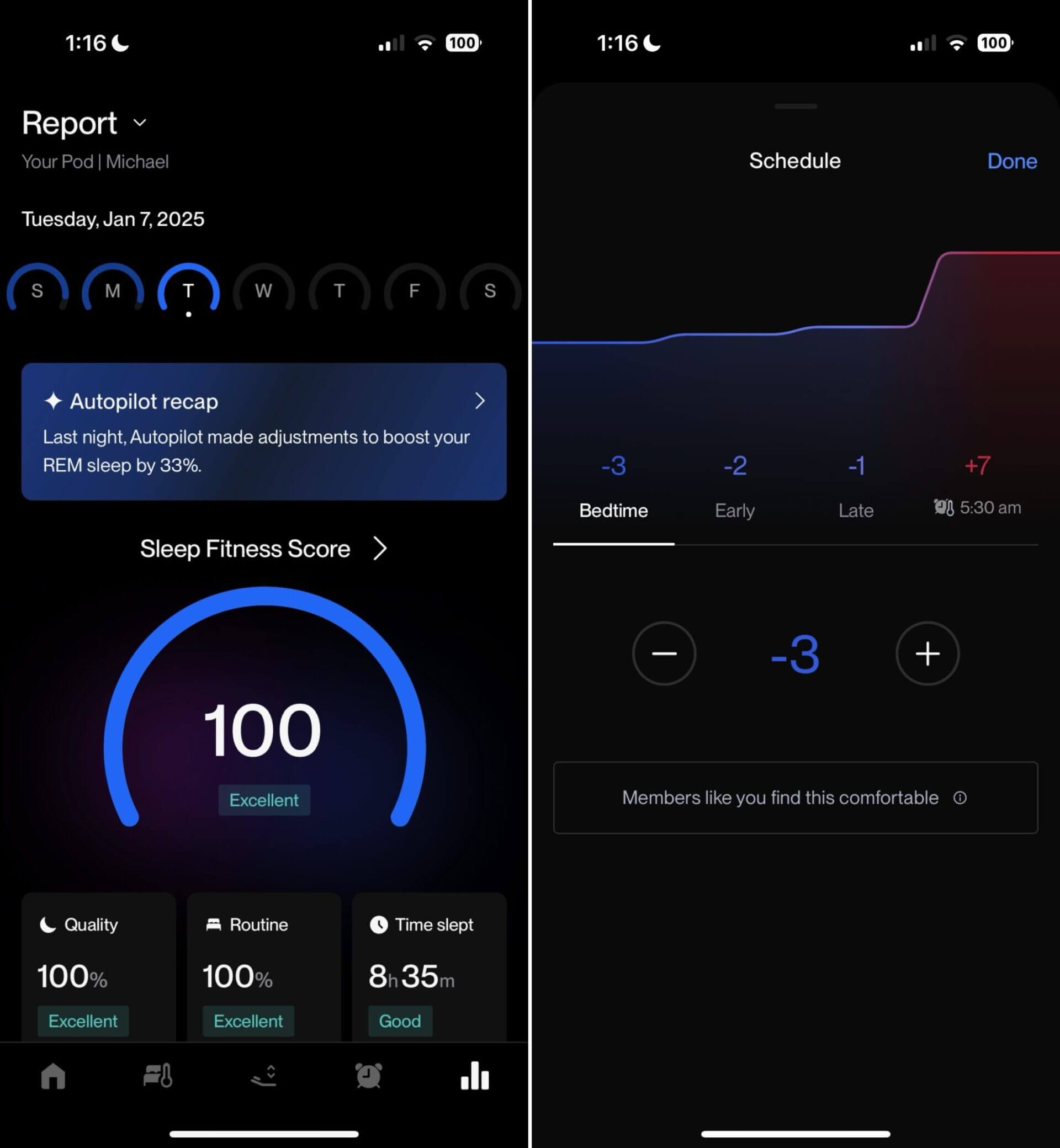
While I have a love/hate relationship with Eight Sleep — the company and the product — I can honestly say that the Pod system has had a dramatic (positive) impact on the quality of my sleep. In a nutshell, I no longer get too hot or cold at night, and I have more nights where I spend at least 40% of my sleep in restorative phases (a good benchmark for a quality night’s rest).
It’s not that my wife and I slept poorly before switching to Eight Sleep. We’ve always kept a relatively strict sleep routine that has produced positive sleep results. But Eight Sleep has helped both of us to get to the next level of sleep quality.
If you’re someone who has been struggling with getting enough quality sleep, or if you suffer from insomnia or high temperatures in your bedroom, I strongly believe that Eight Sleep can make a huge impact for you.
As a side note, after we received our new Pod 4 Ultra, we gifted our old Pod 3 to our friends Jessica and Bryan (who I often mention here on the blog). They reported a dramatic shift in their sleep quality. Jessica in particular has always had trouble sleeping for more than five to six hours — often getting even less sleep than that. She would wake up several times a night and not be able to fall back asleep. Ever since adding Eight Sleep to their existing mattress, she sleeps seven to nine hours each night and says that it has completely changed her life.
I realize this is anecdotal, but I wanted to share it as another real-world example of Eight Sleep making a notable improvement in sleep quality — and also to reiterate that you can get most of the benefits of the system with just the Pod (and even with earlier generations of the Pod).
What’s New With the Pod 4
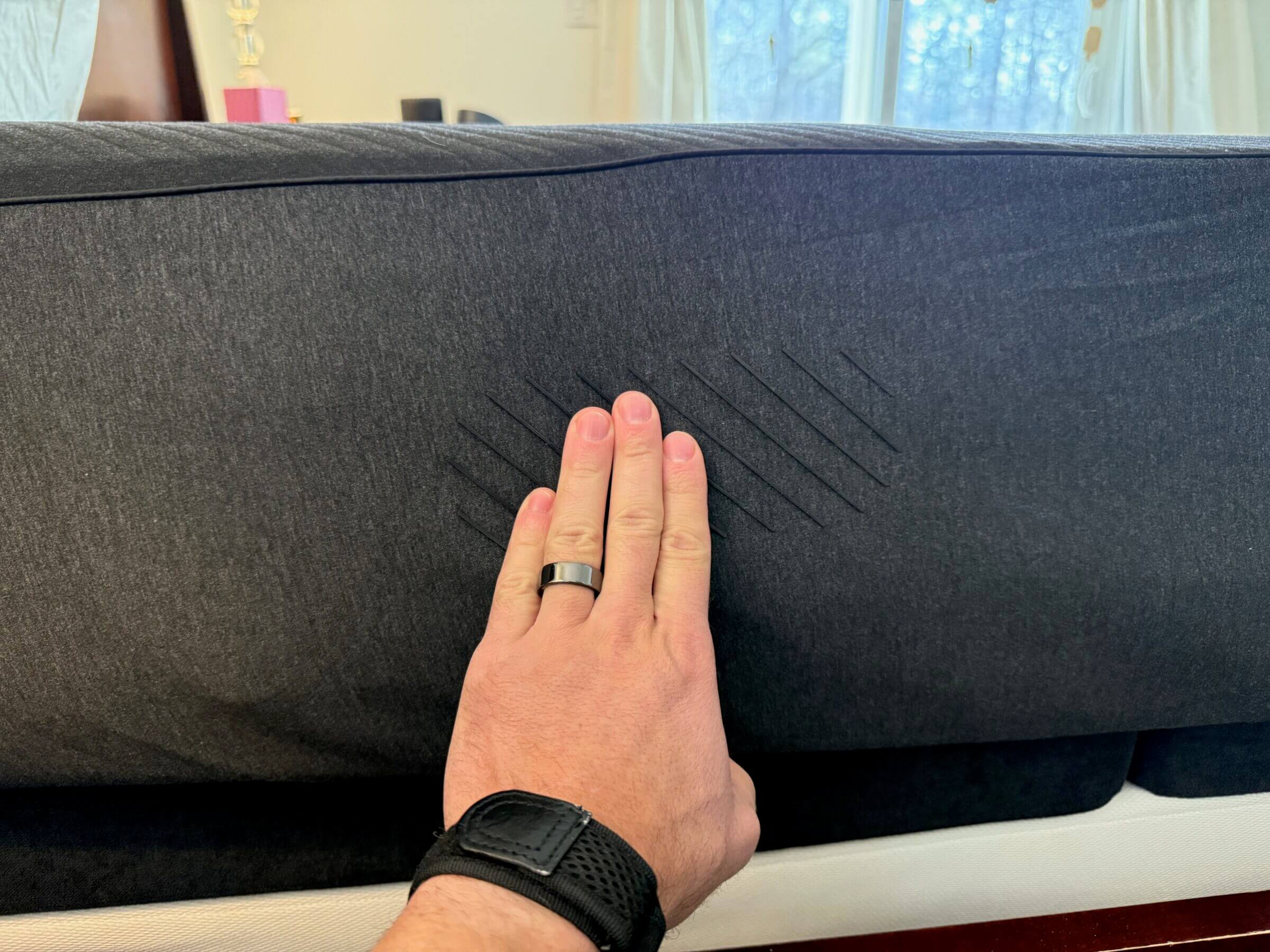
Here’s an overview of the Pod 4’s new features, and whether or not they offer additional benefits over the previous-generation Pod 3, which you can still purchase (for around $300 less than the Pod 4).
Better cooling performance: Eight Sleep claims that the Pod 4 offers “double” the cooling performance of the Pod 3, in the sense that it can reach the desired temperature in half the time. Frankly, I never had any complaints about the cooling performance of the Pod 3, and neither my wife nor I can tell the difference. But if you’re an incredibly hot sleeper, the extra cooling performance can come in handy, as it might make the difference between optimal and less-than-optimal sleep performance. For everyone else, I don’t know that the improved cooling performance is enough reason to purchase the new system.
Quieter operation: As with the system’s cooling performance, I never had any complaints about the Pod 3’s noise (especially when compared to the relatively loud cooling solutions offered by Eight Sleep’s only real competitor, Sleep.me). However, I will say that in a perfectly quiet room, the Pod 4’s Hub is even less noisy.
Touch-based controls built into the cover: I prefer leaving my phone charging in my office at night, instead of keeping it on my nightstand (even when in airplane mode). That way, I’m not incentivized to pick up my phone first thing in the morning. With the Pod 3, that meant I wasn’t able to adjust the temperature without getting out of bed. The new tap sensor that’s built into the Pod 4 Cover allows you to use tap gestures to increase or decrease the temperature, disable or snooze the alarm, or adjust the position of the frame.
Adjustable base: I was excited about the adjustable base that comes with the Ultra edition of the Pod 4, and was equally disappointed when I realized how poorly designed it is. In short, its benefits sound good on paper but aren’t very useful in practice. It also contains a built-in WiFi router, making the WiFi exposure risks associated with the system even worse.
If you’re deciding whether or not to get the (optional) base, I recommend reading this section, which goes into more detail about our experience with it.
Pod 4 Setup Video
How Well Eight Sleep’s Temperature Control System Works
While Eight Sleep’s mattress is comfortable and better at temperature regulation than many competing memory foam options (see the section below for more on that), the company’s innovative temperature control technology is the system’s main selling point and its most valuable feature.
How it works is that the Eight Sleep mattress cover (not the mattress itself) features a grid of soft water tubes (made from silicone) that are sewn into the fabric. The Hub (which is the system’s power source and has a water tank) connects to the Cover and circulates water through those tubes at the desired temperature.
In other words, the Hub heats or cools the water to the desired temperature (based on what stage of sleep you’re in and environmental factors, such as the ambient room temperature) before circulating it through the tubes.
One common question is whether you can feel the silicone tubes of the Cover when you’re in bed. The good news is that the tubes are so soft that you don’t feel them. Of course, if you run your fingers over the cover, you can tell there’s something soft underneath, but the rest of your body won’t be able to tell the difference between a mattress with or without the Cover.
It’s worth noting that you can control the temperature of either side of the mattress individually. So if your partner likes to sleep warmer or colder, that’s an option.
As far as the temperature range is concerned, you can set the Pod to anywhere between “minus 10” to “plus 10” using the Eight Sleep app. That +/-10 scale represents an actual temperature range of 55 to 110 Fahrenheit (13 to 43 Celsius).
In the beginning, I set the temperature to a relatively low setting (-8) and it felt like I was sleeping on a frozen lake.
Since then, I’ve been experimenting with different temperature settings to find the one that works best for me. I’ve also been using Eight Sleep’s Autopilot feature (which requires a paid subscription) that can automatically adjust the temperature settings based on my sleep history and changes in the environment (e.g., the room temperature).
Autopilot is very helpful because your body temperature naturally changes over the course of the night. Plus, your temperature perception can vary based on factors like humidity and the ambient temperature in your room (or even outside).
That’s why Eight Sleep includes sensors in the Active Grid that measure the ambient temperature. These sensors enable the Pod to learn from your environment and make smarter temperature recommendations.
Additionally, you have the option to define different temperature settings for the various stages of sleep, including:
- Bedtime
- Initial sleep stage (deep sleep)
- Final sleep stage (REM sleep)
- Wake up
As part of the setup process — after installing the app and pairing it with the Pod — you can define whether you’re a hot, super hot, cold, or super cold sleeper. The app will then recommend the initial temperature settings.
Of course, you can also simply rely on Autopilot.
In practice, the Pod starts cooling down your mattress (or heating it up, depending on your preference) about an hour before your predefined bedtime.
As you fall asleep (i.e., during the initial sleep stage), the Pod adjusts the temperature to support slow-wave sleep (also known as deep sleep), an important stage of sleep that occurs in longer periods during the first half of the night.
What’s interesting is that your core temperature is typically the lowest a few hours before you wake up, and at a time when most of your REM sleep occurs. Studies have shown that during this phase of sleep, your body’s thermoregulation capabilities are impaired.
In other words, your body could be susceptible to losing too much heat, which can cause you to wake up. You may have experienced this phenomenon, where you wake up during the second half of the night and feel freezing because you uncovered yourself during the first half of the night.
That’s why I have my Pod set to slightly increase the temperature under the covers for my final sleep stage, before cranking up the heat at the very end to encourage me to get out of bed.
Overall, I think the incredibly wide temperature range offered by the Pod should be able to accommodate most sleepers. For those extra “hot” sleepers, the doubled cooling performance of the Pod 4 can easily maintain crisp 55 degrees Fahrenheit under the covers.
Our Take on the Optional Eight Sleep Mattress
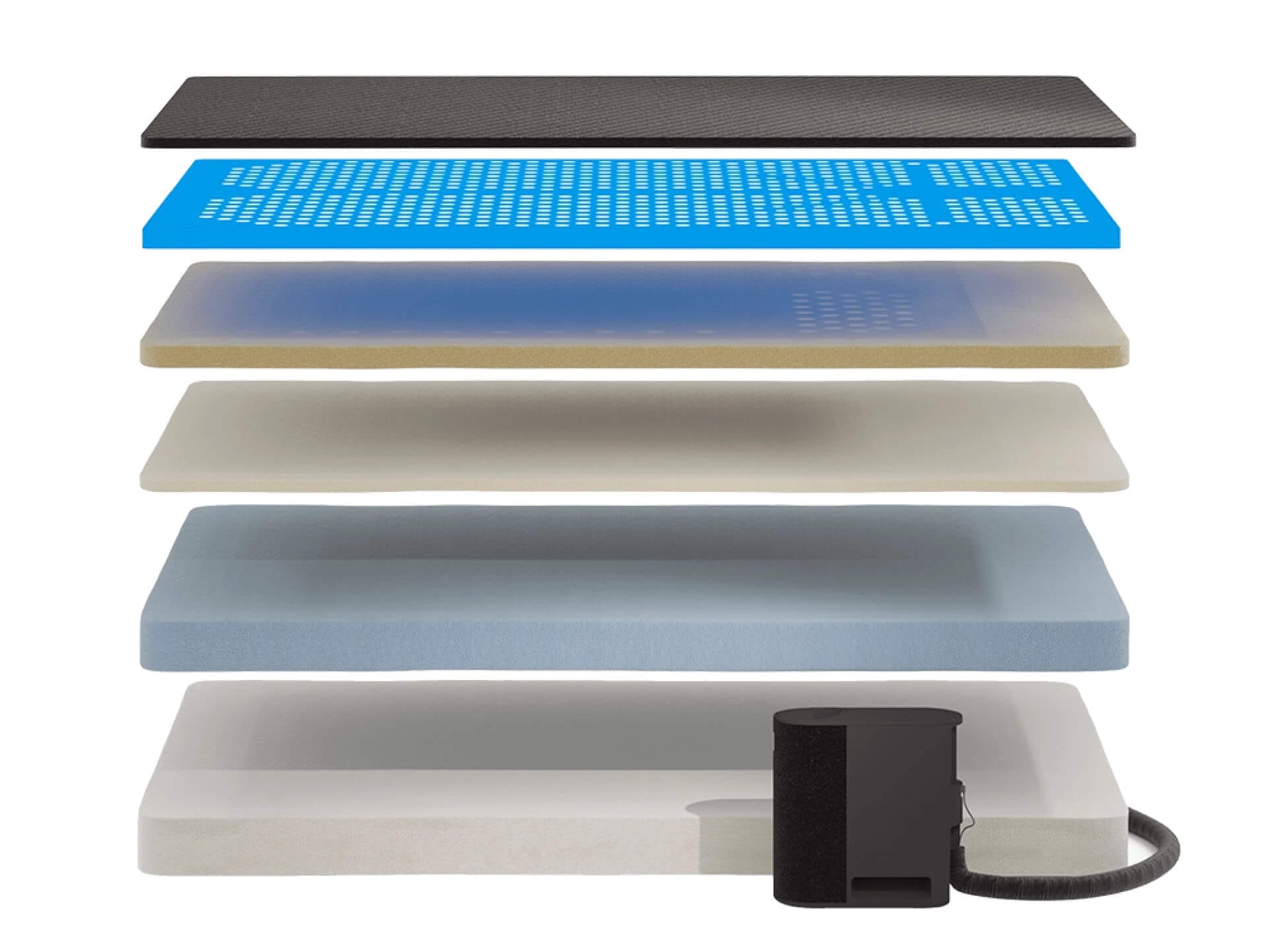
Both my wife and I prefer softer mattresses, because we’ve found that harder mattresses cause pressure points. That became an issue the last time we visited my family in Austria and stayed with my mom and her husband; the bed we slept on had a super-firm mattress that made us feel like we were sleeping on an unpadded floor.
On the other hand, I don’t like a mattress that doesn’t provide enough support to keep my spine and other body parts properly aligned.
Eight Sleep claims that their mattress is made with five layers of CertiPUR-US-certified foam and has an ideal “medium” firmness for providing contouring support.
The CertiPUR-US certification ensures that the foam was manufactured without the use of ozone-depleting chlorofluorocarbons, heavy metals, formaldehyde and phthalates, and that it has low VOC emissions. In other words, the mattress was produced in an environmentally-friendly manner and off-gassing is greatly reduced.
After having slept on our Eight Sleep mattress for a few years, my wife and I have concluded that our mattress is neither too firm nor too soft. It’s comfortable and provides the proper amount of support based on our preferences.
In fact, it’s the best mattress I’ve ever slept on, and I appreciate that it’s more breathable than some of the all-foam mattresses I’ve tried in the past.
Our Take on the Pod 4 Ultra’s Adjustable Base
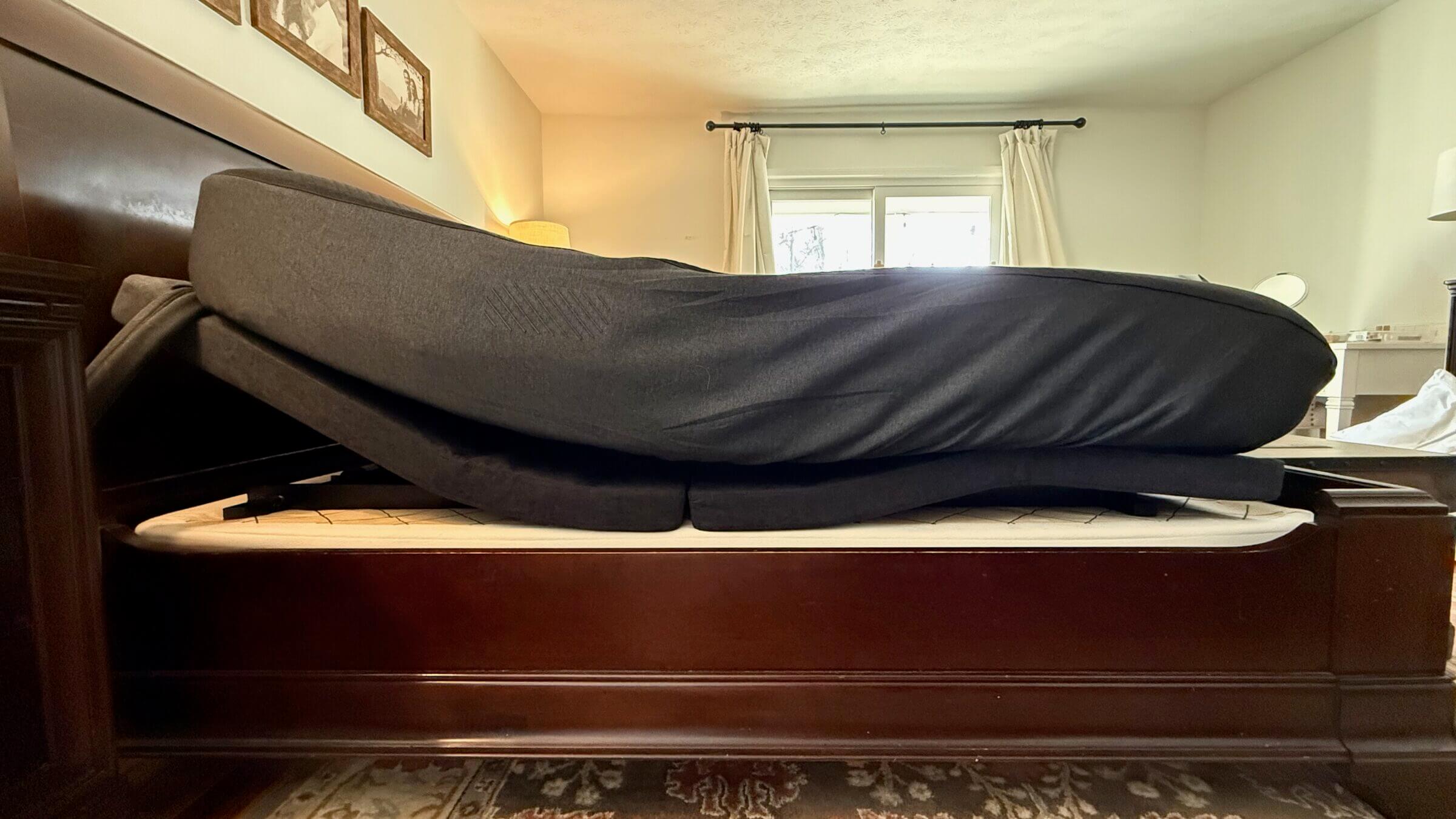
As its name implies, Eight Sleep’s adjustable base sits under your mattress, and it can raise the mattress at the head and legs (around where your knees are). By having that flexibility, you can get into a comfortable position for reading, relaxing or sleeping.
For example, in the reading position, the head and leg sections are raised significantly, while in the relaxing position, they’re raised less. In the sleeping position, both the head and leg sections are raised by only a few inches (to relieve back pressure, if you’re a back sleeper).
Note: All three of these positions are customizable, so you can dial in the exact combinations that work best for you.
Additionally, the Pod 4 Ultra can detect when you’re snoring and automatically raise the mattress’s head section to help you breathe better. I was specifically excited about this, because I tend to snore when I sleep on my back. (Note that this transition happens so slowly and gradually that you barely notice it and, as a rule, it doesn’t wake you up. I noticed it only once or twice while transitioning from one sleep stage to another.)
All the benefits of the adjustable base sound great on paper, but they’re less useful in practice.
For starters, you can’t adjust the base for each side of the bed individually. In other words, if you want to sleep but your partner wants to read, one of you has to sacrifice. The same goes for snoring mitigation; if one of you snores, the head section will lift (and later drop) for both parties.
So unless you and your bed partner share the same routine and sleep habits, the adjustable frame has only limited usefulness.
My wife usually reads longer in bed than I do, so we compromised and elevated the base while we were both reading, before dropping it so I could sleep. She would then resume reading with a second pillow to prop herself up.
Another downside of using the adjustable base is that it creates a significant opening between the headboard and the mattress, which our pillows slid into at night.
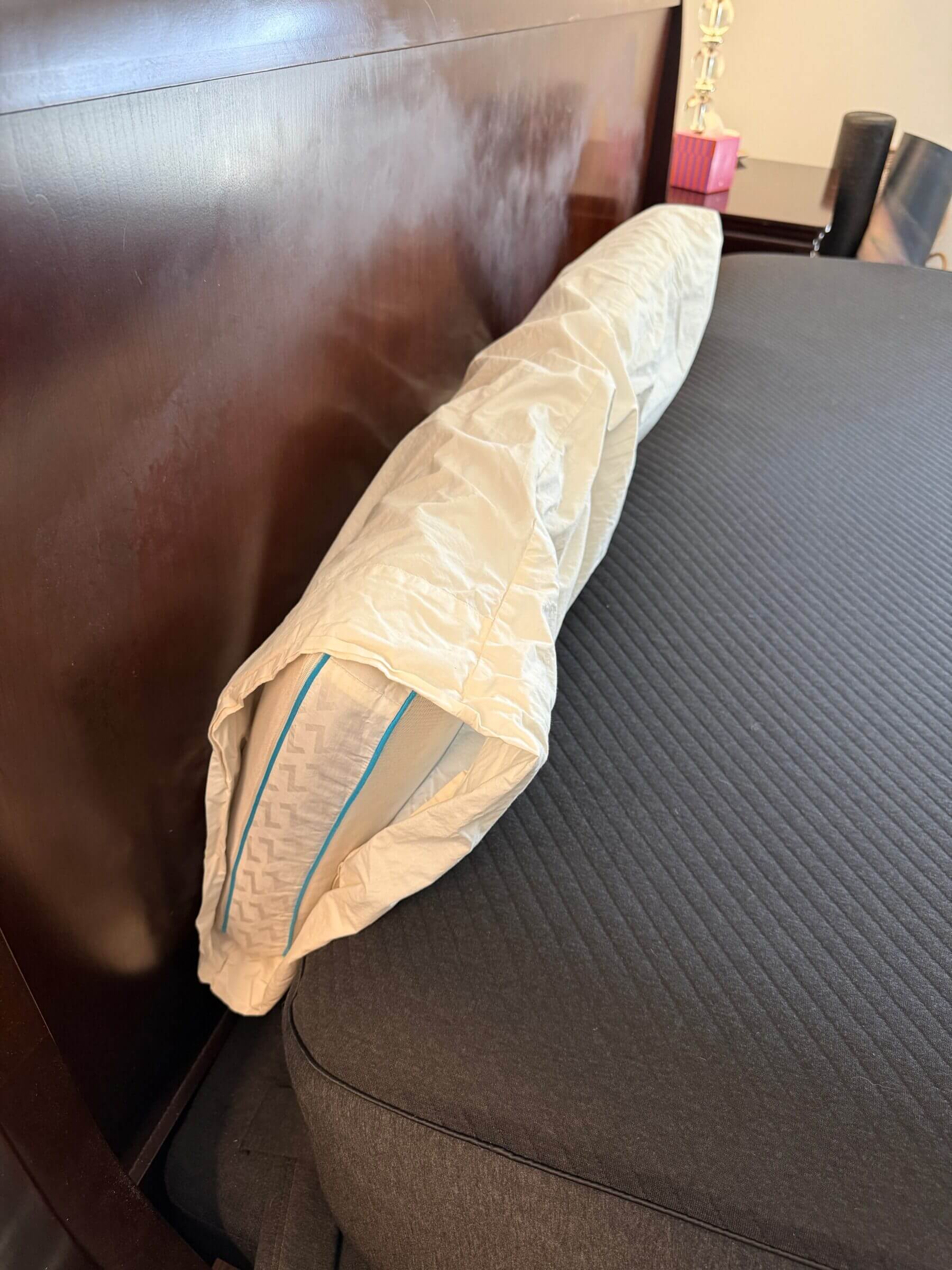
The reason for that is two-fold. First, the base requires sufficient clearance from the headboard to move freely. And second, the underside of the base is slick and doesn’t provide enough friction against our box spring (foundation), causing it to slide down together with the mattress over time.
Initially, I stuffed one of the (useless) accent pillows my wife likes so much into the gap to prevent the pillow I sleep on from dropping into it. But later, I discovered that the gap was the perfect size to hold my primary home defense weapon.
Wireless Connectivity and EMF Concerns
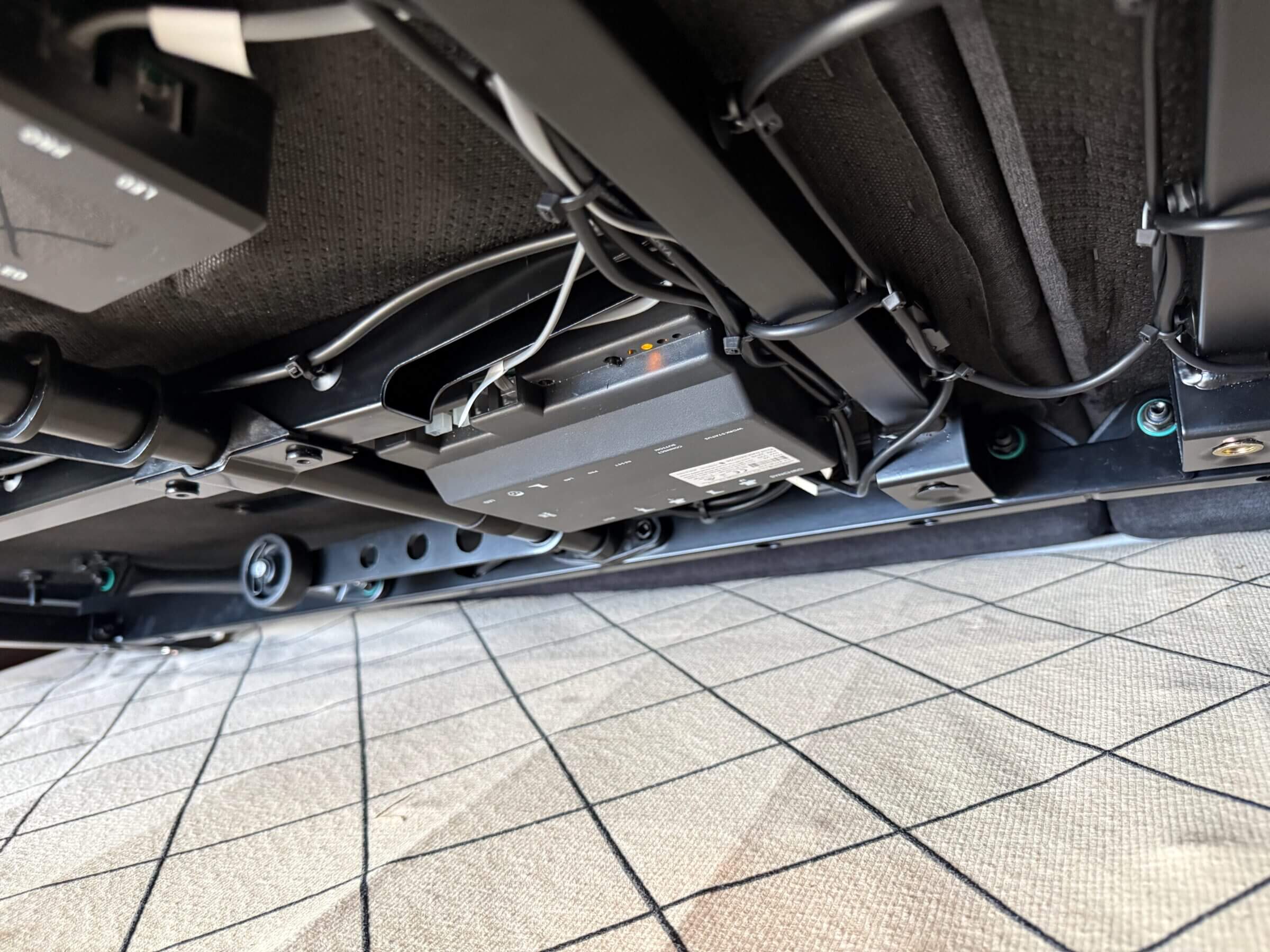
The main reason why we decided to completely unplug the base and stop using it is because Eight Sleep built a WiFi modem into the base to communicate wirelessly with the hub.
In other words, Eight Sleep’s internet access requirement already meant subjecting yourself to constant EMF exposure. But by adding a WiFi modem to the bed itself, the company found a way to make the situation even worse.
That’s a mind-bogglingly stupid move for a sleep fitness company, especially considering the emerging evidence that “radiofrequency devices induce statistically significant changes in the EEG during Non-Rapid Eye Movement (NREM) sleep and suggest these devices may have a clinically important adverse effect on sleep in some people in real-world scenarios.”
When I asked a representative from Eight Sleep about the decision to add a WiFi modem to the base (despite the existing wires that connect the Pod to the Hub), he referred me to an article in the company’s knowledge base suggesting that Eight Sleep has been third-party tested for EMFs and exposure levels are insignificant.
When I pointed out that those tests cover only magnetic exposure, not RF exposure, I never heard back again. That leads me to believe that Eight Sleep has either no clue about EMFs or they don’t care. Either option is unacceptable for a sleep fitness company.
Besides my concerns about increased EMF exposure, it’s also worth mentioning again that the entire Eight Sleep system stops working (as in you can no longer control it) without an active WiFi connection.
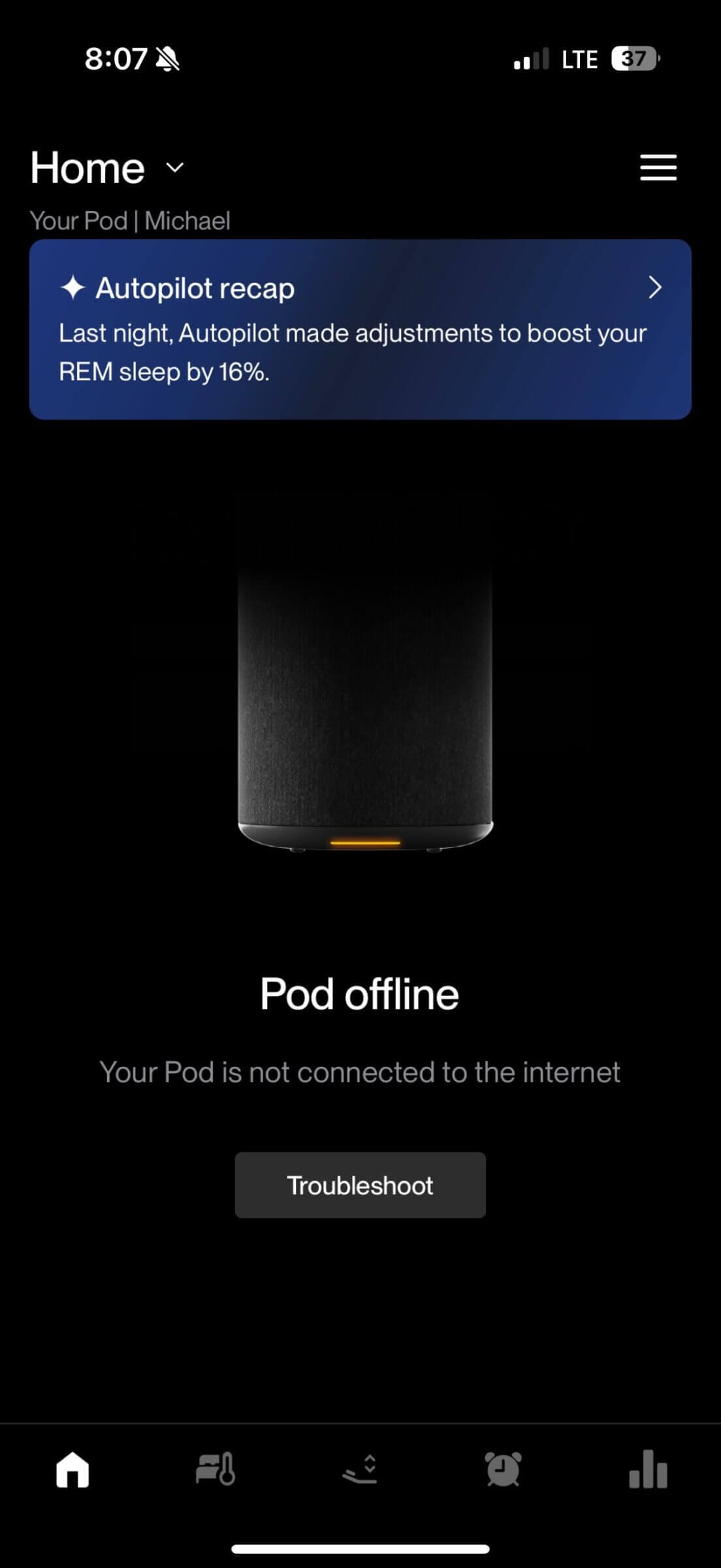
We had an internet outage the other day before going to bed and could not access the system. As a result, we were unable to turn it off (without pulling the cord), change the temperature or silence the alarm. That’s ridiculous considering the Hub is a full-fledged computer that has more than enough horsepower to operate without being connected to the cloud.
When I asked Eight Sleep about the need for WiFi in the past, they claimed that Autopilot requires access to the cloud to calculate on-the-fly temperature changes for optimal sleep performance. I think that’s BS. But even if it was true, I’d be more than happy to rely on my predefined temperature settings in the event I chose to disable WiFi at night, or during periods of internet service disruption.
Sleep Tracking Capabilities and Accuracy
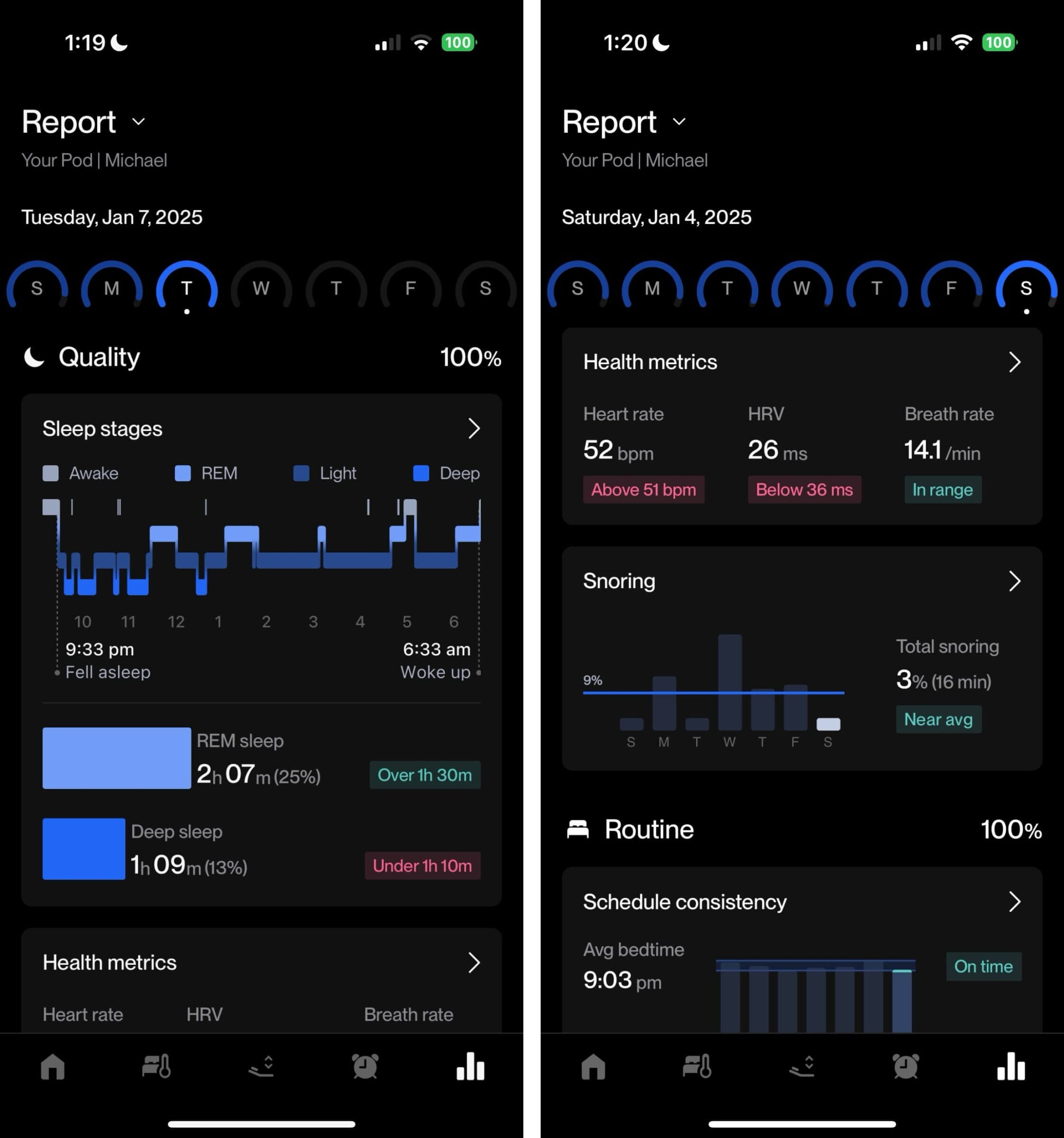
Sleep tracking is one of my passions, so I was excited to test how the non-wearable technology of Eight Sleep compares to my WHOOP strap, Oura Ring and Ultrahuman Ring (which are all wearable devices).
Out of the box, Eight Sleep can track the following metrics:
- Heart rate variability (HRV)
- Out-of-bed events
- Respiratory rate
- Sleeping heart rate
- Stages of sleep (awake, light, deep, REM)
- Time to fall asleep
- Time to leave bed
- Time spent in bed
- Toss and turns
- Wake up consistency
- Snoring
From a technological perspective, Eight Sleep relies on pressure sensors to detect body movement (or lack thereof), to count how often your heart beats (heart rate), and to measure the variability between the timing of your heartbeats (HRV).
As you can imagine, the movement pattern of a beating heart is different from that of your chest as it moves up and down while you breathe. The Pod’s pressure sensors can pick up on those differences to figure out how often you breathe per minute (i.e., your respiratory rate), how often your heart beats, and whether you’re tossing and turning.
Specifically, your movement patterns and your heart rate can help Eight Sleep figure out whether you’re actually sleeping and, if so, what stage of sleep you’re in.
However, as I note in my article about the best sleep tracking devices, a lack of movement and a low heart rate aren’t necessarily reliable indicators of sleep. For example, when comparing WHOOP with Biostrap (another wrist-worn sleep tracker), I found that Biostrap occasionally thought that I was sleeping while I was actually watching TV on the couch. That’s because I didn’t move for an extended period and my heart rate was very low.
The advantage that Eight Sleep has over wearable devices is that it won’t start sleep tracking until you’re actually in bed.
Of course, that’s because Eight Sleep’s assumption is that you go to bed to sleep (or to have sex), but not to watch TV or read a book for extended periods. That assumption might not match your lifestyle. If so, the Pod might not always accurately detect if you’re sleeping or trying to fall asleep.
As far as sleep tracking is concerned, you should know that Eight Sleep does a fairly good job of figuring out how much time I spend in deep and REM sleep when compared to the data provided by my WHOOP Strap, with both platforms confirming that I spend approximately 40% of my sleep in those restorative phases.
Compared to the Ultrahuman ring I’ve been using for the past few months, Eight Sleep consistently reports less deep sleep but similar REM sleep.
Without having access to a sleep lab, it’s impossible to tell which device is more accurate. However, after having tested several sleep trackers over the past years, I have come to the conclusion that they’re all useful for monitoring trends, even if the absolute numbers reported aren’t perfectly accurate. And that information can be just as impactful for improving your sleep.
Outside of sleep tracking, the Pod tracks HRV and HR with 99% accuracy, respectively, based on gold-standard testing methods (according to Eight Sleep). I have found the reported heart rate and heart rate variability numbers to closely match those of my wearable sleep trackers.
Eight Sleep Pricing and Options
Eight Sleep’s system is available in several different configurations and sizes. The prices in the table below reflect list prices and do not include any sales or discounts.
| Configuration | Full | Queen | King | Cali King |
|---|---|---|---|---|
| Pod 3 | $2,195 | $2,295 | $2,495 | $2,495 |
| Pod 4 | $2,449 | $2,599 | $2,849 | $2,849 |
| Pod 4 Ultra | N/A | $4,699 | $4,899 | $4,899 |
Note that when you purchase an Eight Sleep system, you are required to sign up for either a Standard or Enhanced Autopilot subscription, which cost $199 and $299 per year respectively. This membership unlocks features such as Autopilot, sleep tracking, software updates, sleep tools and digital coaching and data insights. You can cancel the membership after your first year.
The Enhanced subscription includes an extended five-year warranty, but it only remains active as long as you maintain that subscription.
Additionally, the optional memory foam mattress costs between $1,899 and $2,099, depending on the size you choose. As a reminder, you can use the Eight Sleep cooling technology with any 10-inch to 11-inch mattress. You do not need to buy the company’s 5-Layer Mattress if you’re happy with your current mattress.
As you can see, the complete Eight Sleep system costs more than some regular mattresses but less than other high-end options from companies such as Sleep Number and Tempur-Pedic — neither of which have the same water-based cooling technology that Eight Sleep offers.
Shop With My Eight Sleep Promo Code
If you’d like to give Eight Sleep a try, make sure to use the link above to save $100 off the purchase price of the complete Pod 4 system (or $200 off the Pod 4 Ultra). The discount code should be auto-applied by clicking the link, but you can also enter coupon code KUMMER at checkout.
You have 30 nights to try the system and send it back if you don’t like it. Eight Sleep will pay for the return shipping and provide a full refund.
How Does Eight Sleep Compare to Similar Sleep Products?
I also had a chance to try the Cube Sleep System for a couple of weeks and incorporated my feedback into a detailed comparison of the best bed cooling systems and this in-depth Cube Sleep System review.
Then, in February 2023, I purchased the Dock Pro from Sleep.me (formerly known as Chilisleep) so that I could do a side-by-side comparison. After a few months of testing, I concluded that Dock Pro’s bed cooling capability is on par with Eight Sleep, although the technology supporting the product is nowhere near as sophisticated.
More specifically, the Dock Pro doesn’t have any sleep or biometric tracking capabilities unless you purchase the additional tracking pad that uses WiFi to transmit data. Considering my aversion to additional EMFs in our bed(room), that wasn’t an option. Additionally, Dock Pro’s temperature control system doesn’t take any environmental factors or behaviors into account. Instead, you can only set specific temperatures for bedtime, sleep and wake-up.
On the bright side, Dock Pro supports airplane mode, which effectively disables the built-in WiFi radio to dramatically reduce EMF exposure at night. I love that and would be more than happy to accept the product’s technological shortcomings for lower EMF levels. Unfortunately, disabling airplane mode doesn’t reliably reconnect the system to WiFi, and you often have to pull the power plug to restart the system. That’s a bit of an inconvenience.
All that said, the biggest drawback of the Dock Pro is its small water reservoir. Having to refill the water tank every couple of days gets old really quickly – especially because you’re supposed to use RO-filtered or distilled water. Of course, with the system in airplane mode, you don’t get notifications when the tank needs to be refilled. As a result, there is a high probability that the tank runs out of water and the system stops cooling in the middle of the night. We’ve had that happen a couple of times and it’s annoying.
With regard to BedJet and similar products, it’s important to remember that products that blow air under your sheets might make you feel a bit cooler, but they don’t actually change the temperature of the mattress surface. Plus, they can dry out your skin, which isn’t good for maintaining optimal skin health.
In contrast, the Eight Sleep mattress cover can reduce the temperature of the mattress surface to 55 degrees Fahrenheit and keep it there, without making any disturbing noise or airflow.
Final Verdict: Eight Sleep Works So Well That We’re Continuing to Use It, Despite the EMF Concerns (For Now)
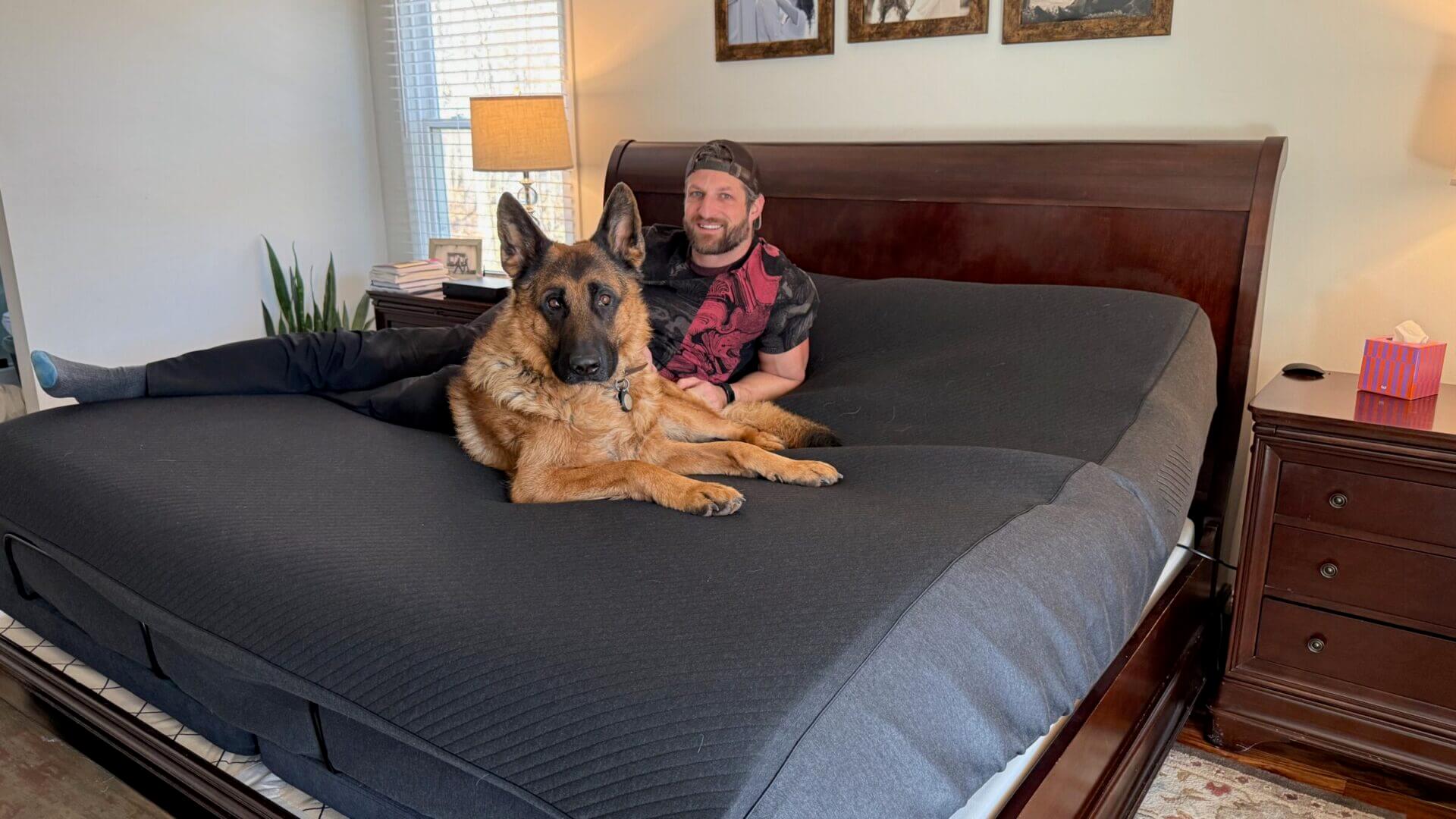
It’s been over four years since we got the Eight Sleep system and I have yet to experience a bad night’s sleep. Both my wife and I love the temperature regulation feature of the device, as well as how comfortable the medium-firm mattress feels.
Compared to our old mattress, which we bought 10 years ago at Ikea, our new high-tech sleep solution feels like it’s light years ahead in terms of comfort and (of course) smart technology. And compared to my testing of other popular temperature-controlled sleep systems, I think Eight Sleep offers the best cooling mattress on the market today.
That said, the company’s stance on EMF exposure and the Pod’s lack of offline capabilities have dramatically changed my perception of Eight Sleep.
As of this writing, I’m still tolerating Eight Sleep in our home because of just how effective the device is at improving my sleep quality. But I will have serious doubts about bringing Eight Sleep with us when we move to our new, 45-acre homestead later this year. At that point, we’ll either switch to Sleep.me and just deal with its inferior design and user experience, or find something entirely different — perhaps a less technological solution.
Another option would be to build a Faraday cage for the Hub and get a dedicated WiFi router that only provides service to Eight Sleep. But to be honest, that seems crazy considering how easy it would be for the company to just enable the device to operate without an internet connection (or to add an Ethernet jack to the Hub).
All of that said, I continue to recommend Eight Sleep to friends, family and you — but with the caveats mentioned in this article.
What’s your opinion about sleeping on top of a WiFi modem (with the Pod 4 Ultra) and requiring a reliable WiFi connection for Eight Sleep to function? Let me know in the comments!
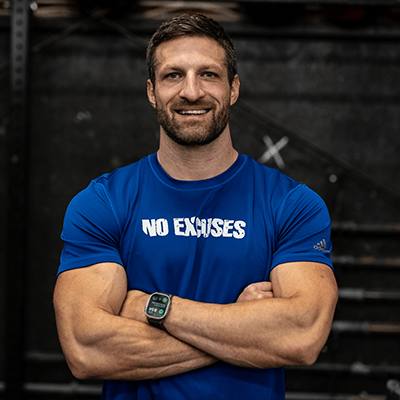
Michael Kummer is a healthy living enthusiast and CrossFit athlete whose goal is to help people achieve optimal health by bridging the gap between ancestral living and the demands of modern society.
Medical Disclaimer
The information shared on this blog is for educational purposes only, is not a substitute for the advice of medical doctors or registered dieticians (which we are not) and should not be used to prevent, diagnose, or treat any condition. Consult with a physician before starting a fitness regimen, adding supplements to your diet, or making other changes that may affect your medications, treatment plan or overall health. MichaelKummer.com and its owner MK Media Group, LLC are not liable for how you use and implement the information shared here, which is based on the opinions of the authors formed after engaging in personal use and research. We recommend products, services, or programs and are sometimes compensated for doing so as affiliates. Please read our Terms and Conditions for further information, including our privacy policy.


Thank you for your review.
It was very clear and easy to understand.
I have one question.
Is the temperature adjustment during sleep automatic?
If so, what kind of temperature changes does it go through
(for example, does the temperature go down or up after falling asleep, or does it rise or fall before waking up)?
Or do you set it manually based on sleep depth, such as ○ before going to bed, △ after you fall asleep, and □ before waking up, or do you use a schedule to set the temperature?
Hey Alice,
Yes, the temperature adjustments of Eight Sleep happen automatically either on predefined settings (you can set a different default temperature for falling asleep, the first- and second half of the night and for waking up) and the Autopilot (if you have it enabled). The latter makes smaller adjustments based on how much you move, the ambient temperature and other factors.
Does that answer your question?
Thank you for explaining everything in detail.
It was very helpful.
For those who may be wondering, Eight Sleep is manufactured in China. As someone who is adamantly trying not to support their unethical manufacturing practices, this is a deal breaker for me.
I hear you! Unfortunately, it’s hard to find any product containing electronics that is not made in China.
Thanks for such an in depth review. Have the pod pro and love the cooling and the marital harmony since we can adjust independently (realistically the best part about it for us), but one thing the 3 says on the website is an increase in comfort, which you did not indicate in your comparison of the 2. I have found the 2 not to be supremely comfortable as a side sleeper as it adds some firmness to the mattress and I’ve wondered if you noticed any difference in the 2. Thanks.
Hey Jim,
Frankly, I have not noticed a difference.
Cheers,
Michael
I have read a lot of Eight Sleep reviews and this is, by far, the most comprehensive. Thank you.
You compared Pod 3 to Whoop but also mentioned you have the Oura wearable but did you ever compare Pod 3 to Oura? I have had my Pod 3 since June 2023, Oura since August 2022 and another wearable called RingConn (no subscription fees and lower cost than Oura). In comparing all 3, generally speaking the data from the Oura was vastly different from both the Pod 3 and the RingConn. In fact, I found Pod 3 and RingConn amazingly consistent evening though there measurment dynamics obviously are very different.
I am obsessed )borderline fanatic about Deep Sleep (even more so than REM). Many times I will get 15-25% Deep sleep with Pod 3 and RingConn and 5% or less with Oura. As you must know, Oura changed their algorithm earlier this year and I actually found it to be worse (I tested the beta version for many months before they went live. Anyway, if I go on any more I’ll have to get my own blog, lol. Thanks.
Hey David,
I’ve noticed the same. Oura is all over the place and often shows less restorative sleep (deep and REM) than any of my other devices. Unfortunately, it’s impossible to tell which device is right and so I stopped worrying about it and just go by how I feel. If I feel rested and energetic, I must have gotten enough restorative sleep :)
One thing I have noticed is that the Pod’s REM sleep reporting seems to be much in line with my dreaming (since we usually dream during REM sleep). That makes me believe that the Pod is likely more accurate (for me) than Oura.
Can the Eight Sleep be shipped to New Zealand?
Hey Ian,
I know Eight Sleep ships to Australia but I’m not sure about NZ. You’d have to reach out to them directly.
Cheers,
Michael
I have a sleep number bed already and was wondering if the pro cover changes the comfort of the bed itself?
Hi Anand,
I don’t have first-hand experience with Sleep Number but I don’t think it would change the comfort because of how thin the Active Grid (cover) is.
Cheers,
Michael
Aren’t you afraid your cat will pop this with its claws?
I have considered getting the Chili pad because you can get 1 side instead of the full cover which I think would reduce said cat claws puncturing it (since my body would block them somewhat). I do like the bells and whistles of the Eight cover though.
Do you feel one cover has more padding than the other which would protect the tubing more?
Hey Cara,
Good point but so far, that hasn’t happened. We usually have a blanket or duvet on top of the mattress and so our cat hasn’t gotten a lot of opportunities to be directly on top of the mattress cover.
Cheers,
Michael
How loud is the controller for the cooling/heating unit?
Not loud at all — you really to make an effort to even hear it.
Hi Michael, thanks for the great review! I’m considering the Pod Cover since I already have a Casper mattress that I like. Are you aware of any differences? I didn’t find anything.
Can you feel the water tubes, electronics, etc? I’m a side/stomach sleeper (and 190lbs) so I’m curious.
Not sure where you live but here in Michigan it gets cold and our upstairs bedroom gets about 65 at night. Have you noticed if the room temp makes much of a difference now?
Lastly, I do love having blankets on but have to kick them off because of being too hot. Are you able to keep blankets on with your Pod?
Thanks again!
Hi Matt!
I haven’t looked at the Casper mattress but I know that a buddy of mine has and loves it. Besides being comfy, the Eight Pro mattress is CertiPur-US certified (not sure about the Casper). Everything else is pretty standard, I’d say.
Regarding the topper, you can’t feel the tubes or sensor wires. I mean, if you probe with your fingers, you can probably make them out and you won’t feel them while in bed.
We live in Georgia and our room cools down to about 66/67 at night. We haven’t changed that since we got Eight Sleep but I guess we could get away with a slightly warmer room if we wanted to.
Regarding blankets — that was one of the reasons why we got the Pod Pro, I wanted to keep my blankets without overheating!
Cheers,
Michael
Awesome, thanks for the reply! Glad to hear that you can’t feel the tubes! I’m assuming you use a mattress protector over it? I’m looking at the Pod Protector too though its pricey.
Do you know if I give any features up by using only the cover and not the mattress?
Thanks!
Hey Matt,
We have the following setup: Mattress > Active Grid > Sheet. That’s it. You won’t lose any features by going with the Pod Pro Cover only (as far as I know). All the smarts are in the topper (Active Grid).
That’s useful — both the difference in technique, and your experience with the two devices being congruent none the less. Thanks for running this to ground!
“The reason for those discrepancies is that Eight Sleep measures HRV during different times of sleep than WHOOP does.” WHOOP is supposed to measure HRV during deep sleep; when does Eight?
Hi Mik,
WHOOP measures the HRV during the last 5 minutes of deep sleep while Eight Sleep takes various readings during deep sleep and then uses an average.
Thanks for that! I’ve been trying to find that information for some time. What’s your source on this for Eight?
Hi Mik,
their PR department. This is what they told me: “HRV is measured throughout the night and we have a custom algorithm that converts continuous reading of HRV to a personalized baseline HRV that is useful to track on day to day basis.”
So, sorry to be finicky, but they don’t actually say they only take readings during deep sleep — just “throughout the night,” correct? This would arguably not be as good as sampling during deep sleep, for reasons you’ve indicated.
Hi Mik,
you’re right. Let me try to get a more scientific answer on when and how they track HRV. Stay tuned!
Hi Mik,
I confirmed that Eight Sleep measures HRV during different phases of sleep (not only deep sleep). That’s the reason why the scores I get from Eight Sleep vs. WHOOP are different. However, interestingly enough, both platforms show very similar trends!